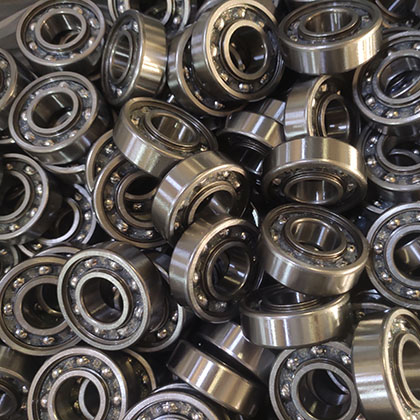
Bearing numbers
Bearing numbers, also known as bearing designations or part numbers, are alphanumeric codes used to identify specific bearings and convey important information about their size, type, and features. These numbers are standardized by organizations such as the International Organization for Standardization (ISO) or the American National Standards Institute (ANSI) to ensure consistency and compatibility across different manufacturers and suppliers.
The format and structure of bearing numbers may vary depending on the bearing type and standard used, but they typically include the following components:
1. Basic Size: The basic size refers to the bore diameter, outer diameter, and width (or height) of the bearing, typically expressed in millimeters (mm) or inches (in). These dimensions are usually included as numerical values following the prefix.
2. Prefix: The prefix indicates the basic type or series of the bearing. For example, common prefixes include “6” for deep groove ball bearings, “22” for self-aligning ball bearings, “NU” for cylindrical roller bearings, and “LM” for tapered roller bearings.
3. Internal Designations: In some cases, manufacturers may use internal designations or codes to further specify certain characteristics of the bearing, such as precision level, material, or special modifications. These designations may be included as part of the bearing number or provided separately in technical documentation.
4. Suffixes: Suffixes may be added to the bearing number to denote additional features, specifications, or variations of the standard bearing design. Examples of suffixes include “ZZ” for shielded bearings, “RS” or “2RS” for sealed bearings, “C3” for bearings with increased internal clearance, and “TN9” for bearings with glass fiber reinforced polyamide cages.
5. Precision Class: Bearing numbers may also indicate the precision class or accuracy level of the bearing, especially in applications where tight tolerances are critical. Precision classes are often denoted by letters such as “P0,” “P6,” “P5,” and “P4,” with higher numbers representing higher levels of precision.
6. Radial Clearance: Some bearing numbers may include information about the radial clearance or internal clearance of the bearing, which refers to the amount of internal space between the rolling elements and the raceways. Common clearance codes include “C2,” “C3,” “C4,” and “C5,” indicating increasing levels of clearance.
7. Special Features or Variants: Bearing numbers may include additional suffixes or codes to indicate special features, variants, or modifications of the standard bearing design. These may include high-temperature bearings, corrosion-resistant bearings, or bearings with special coatings or lubricants.
8. Cage Design: Some bearing numbers specify the type of cage used in the bearing, which holds the rolling elements in place and helps distribute the load evenly. Common cage designations include “J” for steel cage, “M” for brass cage, and “TN” for polymer cage.
9. Global Standards: Bearing numbers are often standardized according to international standards such as ISO, ANSI, or ABMA (American Bearing Manufacturers Association), ensuring consistency and compatibility across different manufacturers and regions.
10. Interchangeability: In some cases, bearing numbers may include information about interchangeability with bearings from other manufacturers or compatibility with standard bearing dimensions. This information helps users source replacements or interchangeable components more easily.
11. Preload and Mounting Arrangements: Some bearing numbers specify preload arrangements or mounting configurations for applications requiring precise axial or radial positioning. Prefixes like “H” or “G” may indicate matched bearing sets for duplex or triplex arrangements, while suffixes like “DB” or “DF” denote specific mounting arrangements.
12. Suffixes for Lubrication: Bearing numbers may include suffixes that denote the type of lubrication used in the bearing. For example, “K” may indicate bearings lubricated with grease, “W” for oil-lubricated bearings, and “L” for bearings with solid lubricants such as oil-impregnated bronze.
13. Sealing or Shielding Options: Bearing numbers may specify sealing or shielding options to protect the bearing from contaminants and retain lubrication. Suffixes like “RS” or “2RS” indicate bearings with rubber seals, while “ZZ” denotes bearings with metal shields. These suffixes may also indicate the number of seals or shields present.
14. Dimensional Accuracy and Running Accuracy: Bearing numbers may include codes related to dimensional accuracy and running accuracy, indicating how closely the bearing conforms to specified dimensions and how smoothly it operates. Common codes include “D” for normal accuracy, “P6” for higher accuracy, and “PN” for precision bearings.
15. Obsolete or Discontinued Bearings: Bearing numbers may also indicate when a particular bearing model has been discontinued or replaced by a newer version. This information helps users identify obsolete bearings and find suitable replacements or alternatives.
16. Custom or Specialized Bearings: In some cases, bearing numbers may include custom or specialized designations to indicate unique features or configurations tailored to specific applications. These designations may be provided by the manufacturer based on customer requirements or industry standards.
NSAR, a professional deep groove ball bearings supplier in China, provides a broad variety of deep groove ball bearing with best customer service and quality assured. With more than 20 yearsdeep groove ball bearings manufacture experience, our deep groove ball bearing has been exported to United States, Canada, Mexico, Brazil, Argentina. you can products download,NSAR can satisfy your bulk deep groove ball bearing customization needs,We provide 6012 bearing and 6000 bearings series and 6200 bearings series and 6800 bearings and pillow block ball bearings and 6300 bearing.
Understanding these additional aspects of bearing numbers can further assist users in selecting the right bearings for their applications, ensuring proper fit, performance, and reliability. Manufacturers typically provide detailed documentation and technical support to help users interpret bearing numbers and make informed decisions during the selection process.

